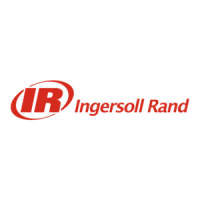
Do you have a question about the Ingersoll-Rand THERMO KING Precedent C-600 and is the answer not in the manual?
| Model | Precedent C-600 |
|---|---|
| Category | Refrigerator |
| BTU/hr @ 0°F | 34, 000 |
| Refrigerant | R-452A |
| Voltage | 12V DC |
| Power Source | Diesel |
| Temperature Range | -20°F to +80°F |
Explains hazard symbols, general practices, and specific warnings.
Procedures and warnings for automatic unit startup and operation.
Warnings and precautions regarding high voltage hazards.
Guidelines for safe battery installation and cable management.
Warns about fire hazards related to fuel lines and electrical harnesses.
Specifies necessary PPE when working with batteries.
Details explosion hazards related to battery terminals.
Safety procedures for connecting battery cables.
Warning against connecting non-approved equipment to the unit.
Precautions when working with refrigerants.
Hazards associated with refrigerant in the presence of flame or sparks.
Risks of inhaling refrigerant vapor in confined spaces.
PPE for handling liquid refrigerant to prevent frostbite.
Safety precautions for working with refrigerant oil.
First aid for refrigerant, oil, coolant, battery acid, and electrical shock.
Emergency response for electrical shock and asphyxiation.
Location of safety decals and information on high voltage components.
Information on California Proposition 65 warning labels.
General overview, diesel engine, coolant, and EMI 3000 package.
Details on compressor, ETV, and the SR-4 control system.
Diesel, electric modes, and explanation of the defrost process.
Automatic/manual defrost and CYCLE-SENTRY system features.
Steps for inspecting the unit and trailer before loading cargo.
Inspection of cargo box, doors, and defrost drains.
Introduction to operating the SR-4 controller and its interface.
Details on the microprocessor switch and HMI panel.
Explains the control panel display and its icons.
Explanation of hard keys and soft keys on the control panel.
Procedure for turning the unit on and flash drive detection.
Options for downloading and flash-loading data via USB.
Customizing soft key functions for user convenience.
Heater function and selecting display languages.
Procedures for changing numerical and named product setpoints.
Steps for starting the diesel and electric motors.
Procedures for switching between diesel and electric operation.
Initiating and terminating manual defrost cycles.
Selecting Cycle Sentry or Continuous modes.
Accessing unit gauges and sensor readings via dedicated keys.
List and description of available gauges and I/O conditions.
Accessing unit sensor readings.
List and description of available sensor readings.
Navigating and accessing submenus within the Main Menu.
Overview of the options available in the Main Menu.
Steps, conditions, and considerations for performing a Pretrip Test.
Using USB flash drives for data download and software updates.
Handling flash drives during startup and removal.
Managing and selecting display languages for the HMI.
Introduction to alarms and explanation of log alarms.
Description of check and prevent alarms and their implications.
Shutdown alarms, pretrip codes, and alarm handling during mode changes.
Procedures for clearing various types of alarm codes.
Using the Alarm Menu to view and clear active alarms.
Notes on alarm clearing and persistence.
Steps to access and view unit gauges.
Steps to access and view unit sensor readings.
Sending trip markers and printing data logger reports.
Viewing enabled hourmeters and understanding their definitions.
Using the Change Mode Menu for various settings.
Procedure to enable or disable Cycle Sentry Mode.
How to select Fahrenheit or Celsius units for display.
Operation of the Fresh Air Exchange door.
Enabling and disabling keypad lockout for security.
Setting the unit to sleep mode for warm-up and battery charging.
How electric and diesel modes operate with SmartPower.
Manual switching between diesel and electric operation.
Unit response when electric standby power is lost or disconnected.
Adjusting HMI display brightness levels.
Checking the unit's time and date.
Clearing Engine Control Unit (ECU) fault codes.
General info on alarms and their classification.
Explanation of log alarms and their indications on startup.
Description of check and prevent alarms and their implications.
Shutdown alarms, pretrip codes, and alarm handling during mode changes.
Procedures for clearing various types of alarm codes.
Using the Alarm Menu to view and clear active alarms.
Notes on alarm clearing and persistence.
Steps to access and view unit gauges.
Steps to access and view unit sensor readings.
Sending trip markers and printing data logger reports.
Viewing enabled hourmeters and understanding their definitions.
Using the Change Mode Menu for various settings.
Procedure to enable or disable Cycle Sentry Mode.
How to select Fahrenheit or Celsius units for display.
Operation of the Fresh Air Exchange door.
Enabling and disabling keypad lockout for security.
Setting the unit to sleep mode for warm-up and battery charging.
Steps for inspecting the unit and trailer before loading cargo.
Verifying the cargo has been properly loaded.
Procedures for enroute inspections and troubleshooting temperature issues.
PPE, explosion hazards, and general jump starting precautions.
Details on engine model, fuel type, oil, filters, and coolant.
Electrical control, battery, standby, motor, and relay specs.
Requirements for supply circuit breakers and extension cords.
Maintenance tasks for the microprocessor and engine based on hours.
Maintenance tasks for electrical and refrigeration systems.
Maintenance tasks for structural integrity and cleaning.
Identifies locations for finding the unit's serial number.
Details on EPA and ARB Supplemental Emissions Warranty coverage.